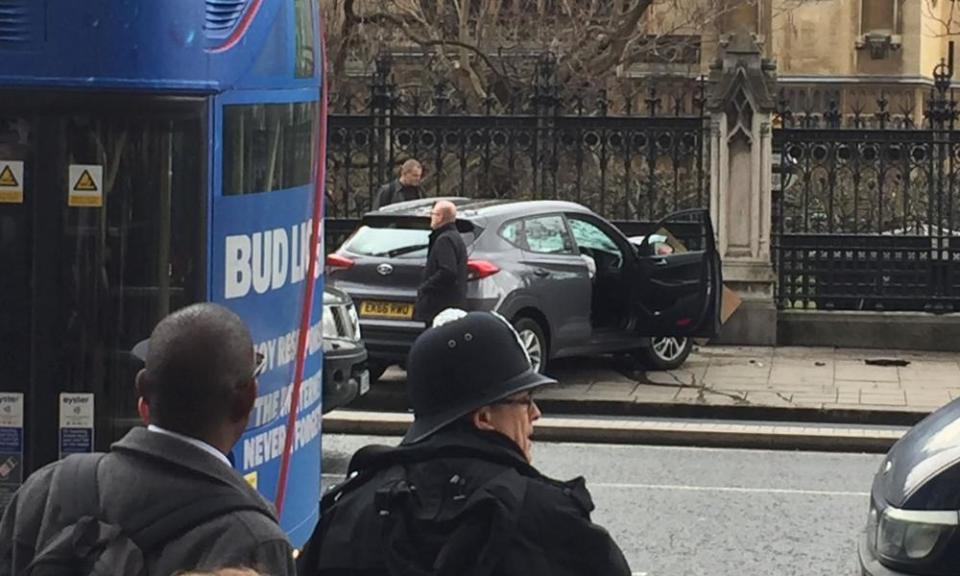Crude nature of Westminster attack suggests limited Isis network in Britain

The attack outside the Houses of Parliament in London is the latest in a series of terrorist atrocities involving a vehicle being driven at speed into pedestrians – a tactic actively promoted by Islamic State.
In December, a refugee in Germany drove a truck into a market in Berlin, killing 12.
Last July a stolen truck driven through a Bastille Day parade in Nice killed 86. The strikes appear inspired, if not actively commissioned, by Isis in Iraq and Syria.
In November a student used a vehicle and knives to injure 13 on a campus in Ohio, in the US. His motives and allegiance are less clear.
Such attacks are not unprecedented, but have become much more numerous in recent years.
In 2014 the chief spokesman of the group, Mohammed al-Adnani, issued a call for sympathisers in the west to strike “unbelievers”, especially police officers or soldiers, where they were – rather than travel to the middle east to fight there.

“If you are not able to find a bomb or a bullet, then smash his head with a rock, or slaughter him with a knife, or run him over with your car, or throw him down from a high place, or choke him, or poison him,” he said.
Though al-Adnani, who was killed in 2016, pointed a finger specifically at France, where there were two vehicle attacks in 2014, he also cited the UK among preferred targets.
As the military tide began to turn against the jihadi group in 2016, Isis urgently repeated its call. Isis had hoped to attack in the UK with more conventional tactics such as those used to such terrible effect in Paris in November 2015 and Brussels a year ago to the day of the Westminster attack.
But despite the significant number of British nationals who had joined their ranks in Iraq and Syria, security officials say the group has lacked a network with the same deadly coherence and efficacy as that in France and Belgium.
The fact that a Belgian recruit may have been employed to survey possible targets in Britain – not a UK citizen – in 2015 underlines their shortage. An alternative was individuals using whatever they could lay their hands on.
The US too has seen a string of attacks by individuals – or in one case a couple – who have declared their allegiance to Isis before launching deadly strikes in which scores have died.
British security officials say the UK’s strict gun control laws – and the absence of significant illegal markets such as that in Belgium – have been key to preventing such attacks in the UK.
Over the past 15 years, the vast majority of strikes, whether in Iraq, Afghanistan or the west, have involved weapons that are relatively easy to obtain.
They have also almost all been committed within an hour’s travel of the attacker’s home and, despite the tendency to label individual attackers “lone wolves”, have involved networks.
Research has shown that between half and two-thirds of lone attackers signal their intent to relatives or friends before executing a violent act. Most have links to broader networks or active Islamist groups, some non-violent. Associates of the Nice and Berlin attackers have been detained.
There have also been attacks in Israel and the occupied territories, where cars have been used in a series of lethal attacks by Palestinians on Jewish targets.
The tactic has led to unrest being called the “run-over intifada” and generated cartoons and songs on social media calling for the use of vehicles as weapons.
These have inevitably circulated well beyond the Middle East. Uighur militants based in western China have used both vehicles and knives in attacks over the past decade.
Security officials have long emphasised it was a question of when, not if, an attack would be carried out in the UK. The threat level has long been judged “severe,” which means an attack is seen as highly likely.
In January, Richard Walton, the recently retired head of the Met’s counter-terrorism command, said the threat was “complex, diverse, and one we’ve not seen before”.
The call for individual violent acts in support of the greater jihadist cause is not new. It has its roots in jihadi ideology going back to the 1980s and before.
The veteran rival of Isis – al-Qaida – has long backed such actions and has also repeatedly targeted London. In 2005 the group commissioned and trained the leader of the 7/7 plotters who went on to kill 52 on the London Underground.
When such attacks became logistically difficult, al-Qaida sought to execute or inspire smaller scale operations, although its leaders rejected a suggestion that blades be attached to a tractor which would be driven through a crowd. However, al-Qaida publications did encourage strikes using vehicles.
Britain’s only Islamist-related terrorist casualty since 2005 was Lee Rigby, an off-duty soldier who was killed in south-east London in 2013 when he was run down by a car driven by two Islamic militants and then stabbed to death.
The threat has increased “exponentially” since 2011, security officials have said. As Isis disintegrates, al-Qaida remains resilient and while the Islamist extremist ideology continues to attract new followers the threat will not decline substantially in the near future.

 Yahoo News
Yahoo News 